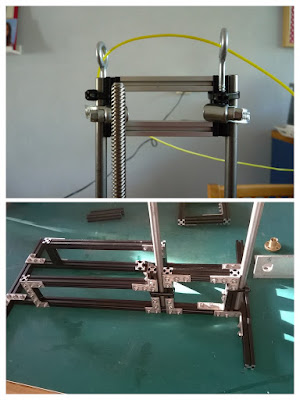For only €20,- I purchased an Acorn Electron in excellent condition. The Electron was developed around 1982 as a direct competitor to the the Sinclair Spectrum, and even though it had some drawbacks it was sold in such large quantities that it is not to rare today. No need to tell the history, since there is already
an excellent article on The Register about that.
Although this machine was not really on my wish-list it's a pleasant surprise. First it's very compact and well-built. The housing is made of solid plastic, which even after 30 years does not show any colouring or scratches.
The keyboard is pretty good, and although most keys have multiple functions they are not crammed with it like the Commodore 64 or Sinclair spectrum.
The inside looks equally good. Just four screws have to be taken out to reveal a very clean motherboard and separate power supply .
They were very serious about the shielding against electromagnetic radiation, as clearly visible on the keyboard side.
The user guide is excellent. It starts (as many user guides from this era) with an explanation of what a computer is:
"A computer is a general purpose electronic machine that can be
instructed to do a great variety of things - play games, perform complex
calculations, store and retrieve information, display graphs and so on."
What surprised me is the possibilities of the Basic interpreter. It actually has named functions and procedures, a 'repeat..until' loop, quite advanced graphic functions and a built-in assembler to write machine code. And this machine code is definitely worth checking out, because the Basic is not really fast...
Enabling Colour on the composite video output
After working with it for while having it connected to a LCD monitor I noticed that it did not display colour. Initially worried that maybe the video circuit was damaged, I soon found out that this is intentional. The standard composite video output is set to black and white, but there is a link on the board that can be made to enable the colour signal.
It's marked 'LK4', and I just soldered a link on it. After that the monitor shows colour as expected, but I do have the impression that the letters are less crisp (which was probably the reason for Acorn to have just black and white as a default)
Loading software
The machine came without a cassette recorder, but it should work with any standard audio recorder. Which in these days can be replaced by simple recording / replay software on a PC. I used Audacity to record a simple Basic program, and after fiddling a bit with the audio levels (for recording as well as playback) it worked fine.
Loading standard software appeared a bit harder. Almost all software published for the Electron is available online, usually in the '.UEF' ('Universal Emulator Format') file format. A very simple Windows program named
FreeUEF can be used to either replay it as audio or to convert it to a .WAV file that can be replayed by other software. The last solution did not really work for me. Replaying the created .WAV files using Audacity always gave an error after reading the first block. All other blocks seem to load fine, but the program will not run on the Electron.

Finally I used an Android App on my tablet named '
TapDancer'. This works flawlessly and because it actually looks like a Commodore Datasette it adds a little extra to the retro-feeling...
And if you want to go a step further, there is the
GoSDC expansion module that lets you load programs from an SD card. But let's face it: compared to loading programs using the tape interface it only saves you a minute during the loading itself. So unless you switch programs every 5 minutes I doubt if this is really worth it.















